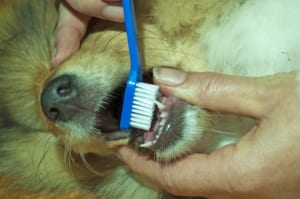The 411 on Brushing Your Pet’s Teeth

It is never too early to start brushing your pet’s teeth. In fact, the younger they are, the better. Tooth brushing should be a bonding experience between you and your pet, constantly reinforced with praise and rewards. Teaching your pet to accept a toothbrush will not happen overnight. It will take time and patience. Hopefully, with these steps and guidance, we will have you both enjoying brushing in no time!
What you will need:
- Baby toothbrush, pet toothbrush, or finger brush.
Note: If your pet won’t tolerate the brush, a small washcloth will do.
- Pet tooth paste, which comes in a variety of flavors (e.g., poultry, beef, vanilla mint).
Note: Do not use toothpaste for people or baking soda to brush your dog’s teeth. Human toothpaste is made with ingredients that are toxic when swallowed.
- Your pet’s favorite treats or rewards.
When:
- Pick a time when your pet is likely to be hungry and is quiet and calm. You want your pet to be relaxed and responsive to your commands.
Where:
- In a quiet area, free from distractions.
- A small dog would work best in your lap, while a larger dog should be asked to sit on the floor. A cat would probably be best placed next to you on a couch or chair.
Technique:
- Start with a brief time of affectionate touching and giving treats if they stay calm and listen to commands.
- Next, lightly touch around the face and lips. If going well, you can slowly progress to lifting their lips and slowly and gently rubbing their teeth and gums with your finger. If they remain still and calm, immediately reward them. If they resist or pull away, end the session and try again later or another day. This may take a couple of sessions until they start to feel comfortable with the activity.
Note: If you are worried about being bitten, stop. There are other ways to help care for your pet’s teeth.
- If everything up to this point is going well, you can add in pet toothpaste. Let your pet smell and taste the toothpaste. Find a flavor that they enjoy. Once your pet approves, add a little to your finger and again slowly and gently rub the toothpaste at the base of the gums. If you feel more comfortable, you can also try this on the washcloth.
- Next, bring out the toothbrush. This can be very scary for your pet. So slowly let them smell it and become familiar with it. Touch it to their face. Once they get a feel for it, you can put it under their lips and gently brush.
- When brushing your pet’s teeth, you only need to work on the outside surface (the side facing the cheeks). Use a circular motion, paying close attention to the gum line. Work up to at least 30 seconds on each side.
Note: The goal is to spend 2-3 minutes every day brushing your pet’s teeth.
- This is a process that may take several weeks. You might get two steps ahead and then fall a step behind during the next session. Hang in there and be patient. If at any point you have questions or would like further assistance, don’t hesitate to call us.
- If you notice any problems during your brushing sessions, like red or bleeding gums, bad breath, loose teeth, etc. call us!
Although tooth brushing is ultimately the most effective type of home dental care, we understand not every pet will tolerate it. There are other products on the market to help control plaque and tartar. Always feel free to speak with your Veterinarian or Technician about other methods, including some you can try at home. The Seal of Acceptance from the Veterinary Oral Health Council appears on products that meet defined standards for plaque and tartar control in dogs and cats. You can find a list of these products on the Veterinary Oral Health Council’s website.






